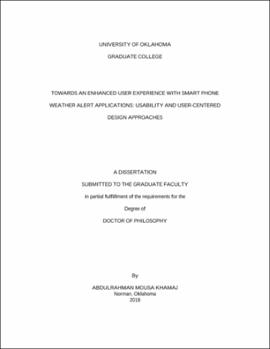| dc.description.abstract | Today, smart phones are ubiquitous in our everyday lives. We rely heavily on their immediately available features, especially when time-critical and/or life-saving information, such as weather alert messages, need to be easily and quickly accessed. With the advancement of smart phone technology, smart phone weather alert applications (apps) have been continuously developed and launched to the market. However, many app developers may pay more attention to creating various features and highly sophisticated tools than considering the most important factors of the design- the usability and users’ needs. Overlooking usability principles and end-users’ needs in the design phase of any system interface can be associated with effectiveness, efficiency, and user satisfaction issues. More importantly, poor usability of time-critical interfaces (e.g. smart phone weather app interfaces) may even hinder performing life-saving actions. So far, only little attention has been devoted to the usability evaluation and end-user needs with weather alert apps on the smart phone platform.
To address this issue, the work in this dissertation is centered on performing systematic usability and user-centered design (UCD) analysis approaches to evaluate and enhance the usability of smart phone weather apps, with a specific focus on first-time users. Specifically, (1) using both traditional (i.e. task completion rate, task completion time and performance surveys) and eye tracking (i.e. eye fixation durations, eye fixation numbers, and scanpath observations) measures, we evaluate the usability of smart phone weather apps with the goal of identifying usability problems; (2) using focus group interviews, we investigate end-users’ goals and needs in weather apps (first UCD phase); (3) considering the focus group findings, general usability heuristics, specific user groups’ (i.e. older users) limitations and recommendations, and smart phone app design principles, we develop a prototype smart phone weather app (second UCD phase); and finally (4) using both quantitative and qualitative evaluation approaches, we evaluate the developed prototype app to validate its usability (last UCD phase). Findings revealed multiple usability problems with currently running smart phone weather apps and showed that the developed prototype app that followed the UCD approach, greatly enhanced users’ experiences of different age groups compared to a representative popular weather app. We make several recommendations for future designs of smart phone weather apps, as well as apps that share similar features and characteristics. | en_US |
